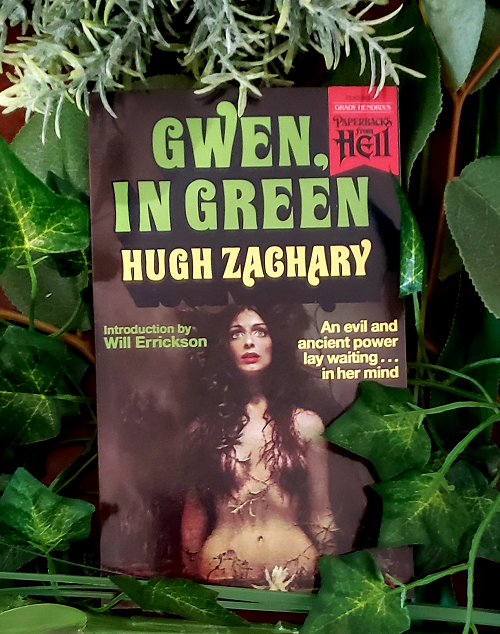#70s pulp

She understood all of it now. Since the clearing operation had been completed, bringing a temporary lull in the mass pain, she’d had time to stand in the edge of the shallow water and communicate. She was more and more a part of it. She was able to submerge herself in it and know true peace. But when the canal digging began she screamed aloud, the sound piercing the unpeopled woodlands and startling birds and a curious squirrel.
She watched them from the island. They were far across the marsh. There was no way to reach them and inflict pain in return. There was only suffering. And suffering could be momentarily eased in only one way. She drove down the island to the pier, saw some of her former friends, and issued invitations: It began again and, her soul hungering for release, bloomed quickly into what ordinary people would have considered a bull market in promiscuity. However, she was no ordinary person. To her had been revealed a Utopia, a heaven of coexistence. That communication was mostly one-way was a problem. She could not explain. And unable to explain, she soon lost the conviction of her own knowledge and shared the incomprehension. It was incredible that such pain could be doled out in such mass quantities. Yet it continued.
Gwen in Green by Hugh Zachary is a sexy revived eco-horror pulp paperback beget from the brutal transformation of 1,200 acres due to construction of the Brunswick Nuclear Plant in North Carolina during the early 1970s.
Its title character twenty-seven-year-old Gwen Ferrier in childhood exposed to her mother’s colorful sex life along with being bullied for it develops a lot of negative feelings around sex. Yet in adulthood she’s managed somewhat decent conjugal relations over the seven years of marriage to her husband George. That is until moving into the couple’s new secluded home on a marshy woodland island begins an obsession with vegetation. At the loss of one of their dogs, knowledge to include the variety of poisonous plants along with fungi. (Sort of a spoiler… but deadly poisoning by the iconic Fly Agaric for humans is exceptionally rare.) Surrounded by Venus fly traps (which btw you should not feed hamburger), experiencing violently grisly nightmares and connection to a peculiar life force drive not only Gwen’s demand for overwhelming sex but, weaponize it towards revenge on behalf of all things green.
This novel among a large list of its author’s works personifies not just nature but a decade. Springing off the likes of plant experiments by Cleve Backster, accompanied by lush descriptions of Carolina barrier island ecology, a perfect setting in summer for lots of bare skin shedding of hotpants and swimwear, downing lots of alcohol in days that loved the double entendre of cocktails like the Slow Screw, all set to tracks such as the Don Ellis orchestra Turkish Delight. Celebrating the period too, the introduction by vintage horror enthusiast Will Errickson refers to some of the defining erotic films of the time. Among these Emmanuellea French art house softcore porn offering out the same year as Gwen in Green. If one is familiar this reference might allude to Gwen’s powerful sexuality and also mentioned journey of increasingly illicit sexual acts. Though Errickson does little to specify, I feel advising that young characters in sexual situations is also something Gwen in Green has in common with the novel version ofEmmanuelle. Though the latter makes a treatise out of it instead of some juvenile fantasy lived out on a page. Such writing tends to make me long for a stiff drink though. Oh, and there’s stiffs to hide and turn up too, not to be forgotten this is a horror tale.
Further many of the supporting characters in thought or deed are blazingly racist and sexist. Reflecting on the characters instead of the author though it may, it’s still something to wade through. Readers might pick out a rebuke or view characters in an unfavorable light as fate darkens. Revenge thrillers take mood. Still, I disagree about all the so dated “momentary offenses” being “mild” or merely “uncomfortable notions”. I fail to see at least how an argument of writing for an often-uncritical mass audience somehow requisites certain cultural references— because there is still choice supposedly among many possibilities. There is also space to work in between challenging the status quo and strengthening it. Plenty of new and older books do reach the heights of bestsellers and literary canon uncritically imbued with the anxieties, attractions, and ails of society. But context helps one understand the why, not a fact to minimize or handwave in defense.
Pulpy and vintage Gwen in Green may be, but a story that still cries out in part because environmental issues and knowledge have only grown since it was written. Gwen as well an example of a potent archetype the like that mainstream pop culture still seems unsure what to do with. Even so, it is a shame that such an vivid novel wasn’t weeded through a bit so to speak. Otherwise, it would be a true classic of eco-horror, and much more readable near half a century later.
Gwen in Green by Hugh Zachary is available in print and digital with a new edition including the original cover painting by George Ziel from Valancourt Books
